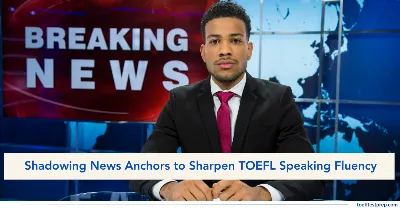Shadowing News Anchors to Sharpen TOEFL iBT® Speaking Fluency

"Want to improve fluency and confidence in TOEFL Speaking? Learn how shadowing news anchors can boost your pronunciation, pacing, and speaking clarity."
Key Highlights
Many TOEFL test-takers aim to improve fluency, pacing, and natural pronunciation in the Speaking section. One highly effective and often underused method is shadowing with news anchor clips.News anchors speak with clarity, confidence, and control. Their smooth intonation and academic tone offer a great model for TOEFL success. Practising with them can greatly enhance your spoken English and boost your overall performance. With regular shadowing, you will become more comfortable speaking at length and sound more natural and organised in your TOEFL responses.
Why Shadowing News Anchors Works for TOEFL Speaking
Here’s why news anchor shadowing is one of the most effective tools to train your fluency and confidence:
-
News anchors use clear, well-paced, and grammatically accurate English—exactly what TOEFL looks for.
-
Mimicking their speech helps you naturally learn correct pronunciation, stress, and intonation.
-
Their tone reflects the academic and formal style expected in TOEFL Speaking tasks.
-
Shadowing trains your brain to process and produce English quickly, improving your response time.
-
It helps reduce filler words and awkward pauses by building rhythm and sentence flow.
-
With regular practice, you gain confidence speaking fluently and clearly on a wide range of topics.
|
You might find this helpful: Common Mistakes to Avoid in TOEFL Speaking Section |
How to Shadow News Anchors: Step-by-Step Plan
Here’s a simple step-by-step plan to help you start shadowing news anchors and improve your TOEFL Speaking iBT skills effectively:
1. Choose the Right Channel
Pick English-language news channels known for clear and neutral pronunciation.
Recommended News Sources:
-
BBC World News
-
CNN International
-
NPR News
-
Al Jazeera English
-
DW News
These channels typically use a formal tone, ideal for TOEFL-style speaking.
2. Select a Short Clip (1–2 Minutes)
Don’t start with long broadcasts. Choose a news report or headline segment that’s short, ideally between 60 and 120 seconds.
3. Listen First Without Speaking
Play the clip once without repeating. Just listen carefully to the anchor’s tone, pauses, and sentence structure.
4. Repeat the Clip, Sentence by Sentence
Pause after every sentence. Repeat the sentence aloud, mimicking the anchor’s pace and pronunciation as closely as possible.
Focus on:
-
Fluency: Speak without unnatural pauses.
-
Pronunciation: Match vowel and consonant sounds.
-
Intonation: Follow the speaker’s tone patterns.
5. Play the Entire Clip and Speak Simultaneously (Shadowing)
Now play the clip again, this time trying to speak at the same time as the anchor. Don’t pause. Try to match the rhythm exactly.
This step improves:
-
Thinking speed in English
-
Real-time word retrieval
-
Confidence in delivering answers
|
TOEFL Speaking Score Calculation: Marking Criteria, Score Interpretation — check now to see how your score is evaluated! |
Benefits of News Anchor Shadowing for TOEFL
Here are the key benefits of shadowing news anchors to boost your TOEFL Speaking performance:
| Skill Area | Improvement You’ll Notice |
|---|---|
| Fluency | Speak more smoothly without hesitation |
| Pronunciation | Clearer vowel/consonant sounds |
| Intonation | Natural rise and fall in sentences |
| Pacing | No rushing or dragging—ideal speed for TOEFL |
| Sentence Rhythm | Awareness of stress, pauses, and sentence breaks |
| Confidence | Reduced nervousness when speaking aloud |
Weekly Shadowing Routine (7-Day Plan)
Here’s a simple weekly shadowing routine to help you stay consistent and improve your speaking skills day by day:
| Day | Task |
|---|---|
| Monday | Shadow a 60-sec BBC clip, focus on pronunciation |
| Tuesday | Repeat same clip with better timing, record yourself |
| Wednesday | Try a new CNN segment, pause after each sentence |
| Thursday | Shadow entire clip without pausing, listen to your version |
| Friday | Try DW News with slightly faster pace |
| Saturday | Mix in Al Jazeera or NPR audio-only clips |
| Sunday | Choose a 2-minute clip, shadow live, record, and evaluate yourself |
| Practising for TOEFL Speaking? Don’t miss these Tips to Handle Unexpected Questions in TOEFL Speaking Section with confidence! |
Example: Anchor Clip Practice Breakdown
Let’s take a BBC World sentence like this:
“The government announced new reforms aimed at tackling inflation, saying the plan will gradually lower prices in key sectors.”
This sentence is packed with useful academic language, clear structure, and natural rhythm—making it a great choice for TOEFL-style speaking practice. Here's how to break it down:
Fluency
Try repeating the full sentence without stopping. Don’t worry if you make mistakes the first time—your goal is to say it smoothly from start to finish. This helps train your breath control and speaking flow, which are crucial for TOEFL Speaking responses.
Pronunciation
Focus on pronouncing difficult or formal words clearly. In this sentence, target “reforms,” “inflation,” and “gradually.” Break them down syllable by syllable if needed. For example, say “in-fla-tion” slowly at first, then speed up gradually while keeping it accurate.
Intonation and Stress
Pay attention to where the speaker puts emphasis. In this case, words like “announced,” “tackling,” and “lower prices” carry the key message. Mimic how the anchor raises or lowers their tone to highlight these parts. This helps your speech sound more natural and expressive.
Self-recording and Comparison
After practising a few times, record yourself saying the sentence. Then play the original news clip and compare. Are your pauses in the same places? Are your stressed words matching theirs? This kind of self-check helps you catch small mistakes and improve faster.
Use Subtitles in the Beginning
If the sentence feels too fast or difficult, turn on subtitles to follow along. Read aloud once with subtitles, then try without them. This step-by-step process builds both confidence and listening skill.
Build Listening Stamina Over Time
After two weeks of daily practice with video clips, start using audio-only news. Without visual clues, your brain works harder to follow the rhythm and structure of spoken English. This mirrors the TOEFL Listening section more closely.
Apply It to TOEFL Practice
Finally, take a related TOEFL-style question and respond using similar vocabulary and tone. For example, based on this news clip, you could practise answering:
“What are some ways governments try to reduce inflation?”
This helps you transfer shadowing practice into your own spontaneous speaking tasks—exactly what you’ll need for TOEFL success.
I hope this blog on shadowing news anchors helped you see how fluency, pacing, and pronunciation can be improved in just a few minutes a day. It’s not about copying perfectly—it’s about training your brain to think and speak in clear, confident English. Keep shadowing daily, and your TOEFL Speaking responses will soon sound more polished and natural.
Additional Resources:
Featured Articles

TOEFL Format Undergoing Significant Changes in January 2026
The TOEFL iBT format is changing in January 2026 with a smarter structure and easier scoring. Here’s everything you need to know to stay ahead.
August 06, 2025
Minimum TOEFL Score Requirement for South Korea Student Visa
Understand the TOEFL requirement for a South Korea student visa and English-taught programs, and prepare your application for success.
September 14, 2025
Minimum TOEFL Score for Study Visa in Poland
Understand TOEFL score requirements for securing a Poland student visa and joining top universities offering English-taught programs.
September 14, 2025
TOEFL Requirements for Animation & VFX Programs Abroad
Discover TOEFL score requirements for studying Animation and VFX abroad, and learn how to meet them for top creative universities.
September 14, 2025